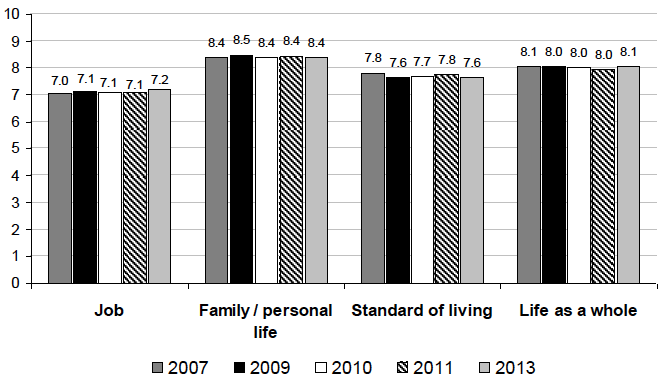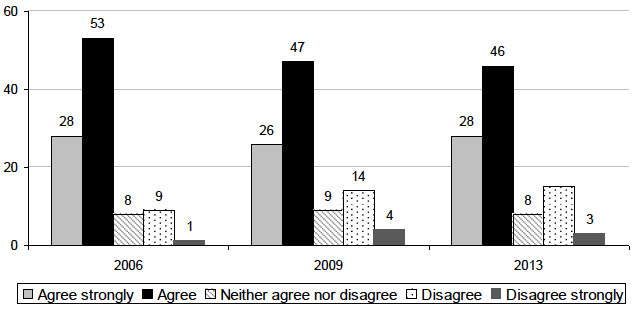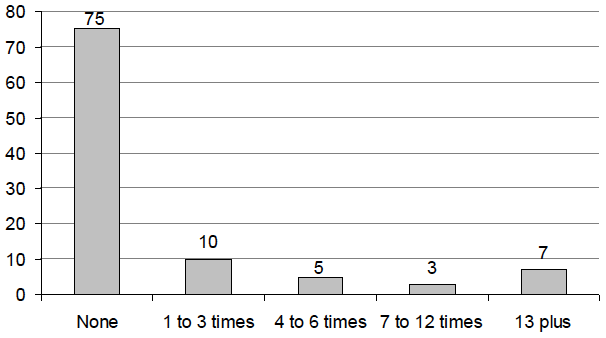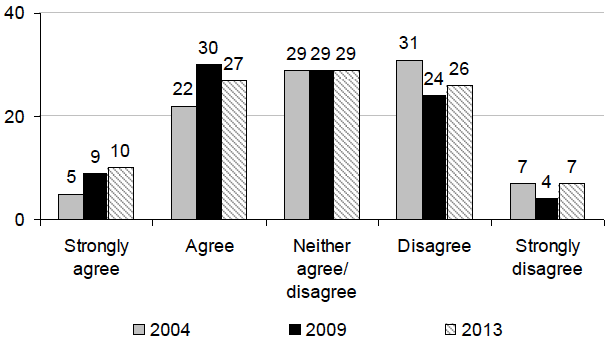Scottish Social Attitudes Survey 2013: core module - attitudes to Government, the economy, health and social care services, and social capital in Scotland
This report presents findings from the Scottish Government core module in the 2013 Scottish Social Attitudes survey. It discusses changing attitudes to government, the economy and standards of living, the health service and social care, and social capital and life satisfaction.
This document is part of a collection
5 Social Capital And Life Satisfaction
5.1 This chapter describes social capital and life satisfaction. The findings cover:
- Levels of satisfaction with life as a whole
- Levels of satisfaction with particular aspects of life including job satisfaction, satisfaction with family and personal life, and satisfaction with standard of living
- The extent of 'social connectedness' people feel with others in their area
- The involvement, and likelihood of future involvement, in civic participation
- Levels of social trust
5.2 The chapter also examines the relationship between social capital and life satisfaction. In particular it explores whether factors relating to social capital provide a better explanation of variations in life satisfaction than can be achieved using demographic factors alone.
Introducing social capital and life satisfaction
5.3 While the concept of social capital is not straightforward to define, there is some convergence over the idea that networks and shared 'norms of reciprocity' are of central importance (Harper, 2002). This is consistent with the definition by the Organisation for Economic Co-operation and Development (OECD) which describes social capital as 'networks together with shared norms, values and understandings that facilitate co-operation within or among groups'. The Office for National Statistics (ONS) has also adopted this definition. However, a report by the ONS (ONS, 2001) illustrates that in practice social capital can be a sprawling concept, including social trust, friendship patterns, membership of clubs, participation in neighbourhood activities, how often people see their family, and whether people know their neighbours. Thus, social capital is a complex and nuanced concept which is difficult to capture through research.
5.4 There are many subcategories of social capital and a useful distinction is made between strong ties and weak ties, the first referring to the ties a person has with their closest friends and family, the second being the broader network of acquaintances, colleagues and friends of friends an individual may have (Easley and Kleinberg, 2010). It has been claimed that weak ties are highly important as they bring together people from different backgrounds, and can help people to progress in life, for example by identifying job opportunities through friends of friends (Harper, 2002). It is also thought that social capital can be described as both a public and a private resource (Putnam, 2000). It is a private good in that individuals with high levels of social capital can benefit from it personally. Putnam and others go further to claim that there are also thought to be diffuse, shared benefits which extend beyond those with high levels of social capital. For example, if people do voluntary work, make an effort to look out for their neighbours or are friendly and trusting towards strangers, this can benefit everyone in a society, not just those with high levels of social capital.
5.5 Not all these aspects of social capital are covered in detail on SSA - and arguably many forms cannot be measured through survey research (Li, 2010). SSA 2013 provides us with a set of questions which measure a respondent's social connectedness; their civic participation including volunteering; motivation and efficacy in terms of the respondent feeling they are willing and able to influence their local area; and generalised social trust.
5.6 Aside from allowing us to observe any changes in these measures of social capital in Scotland[32], these questions have been included on SSA 2013 to enable analysis of their effects on life satisfaction. There is evidence from analysis of the Scottish Health Survey (Ormston, 2012) and from the British Household Panel Survey (Li, 2005) that some elements of social capital have a positive effect on mental wellbeing or happiness. The inclusion of a series of questions on social capital has allowed us to analyse these initial findings in more depth.
5.7 Like social capital, life satisfaction has been of increased academic and policy interest over the past decade or so. The Scottish Government (2013) has included mental wellbeing as one of their National Indicators since 2007 and uses findings from the Scottish Health Survey (SHeS) to monitor this. Note however that on SHeS, a clinical measure of wellbeing is used (known as WEMWBS), whereas on SSA the focus is self-assessed life satisfaction.
Life satisfaction
5.8 Given the economic context described in Chapter One, and low levels of confidence in both the economy and standards of living described in Chapter Three, we might expect to see a reduction in self-assessed life satisfaction since the start of the economic downturn in 2008.
5.9 Four questions on life satisfaction have been asked on SSA since 2006. Each question has an 11 point scale running from 0 (extremely dissatisfied) to 10 (extremely satisfied)[33]. Figure 5.1 presents the mean scores (out of 10) for responses to these questions. The figures are high with a mean score of 8.05 for satisfaction with 'life as a whole' and 7.63 for 'standard of living'. The equivalent score for 'family and personal life' is slightly higher and for job satisfaction is slightly lower.
Figure 5.1 Mean scores for four measures of life satisfaction

Base: All respondents. Sample size: 1497.
See Annex A, Tables A.24, A.25, A.26, A.27 for full details.
5.10 Perhaps the most notable characteristic of these figures is their stability, especially considering this timeframe includes the recent recession. Even the mean score for self-assessed standard of living, which might have been expected to decrease following the recession, has been reasonably stable between 2007 and 2013. No clear trend has been displayed over time, and variations from year-to-year have been less than 0.2. In Table 5.1 we can see that the distribution of responses to each point on the scale for satisfaction with 'life as a whole' is also remarkably stable. The equivalent tables for the other three questions demonstrate a similar pattern. This shows that the mean scores in figure 5.1 do not 'hide' any more subtle variation in responses.
Table 5.1 And all things considered, how satisfied are you with your life as a whole nowadays?
| 2007 | 2009 | 2010 | 2011 | 2013 | |
|---|---|---|---|---|---|
| % | % | % | % | % | |
| 0 (extremely dissatisfied/ unhappy) | * | * | 1 | 1 | * |
| 1 | * | * | * | * | * |
| 2 | * | * | * | 1 | * |
| 3 | 1 | 1 | 1 | 1 | 1 |
| 4 | 1 | 2 | 1 | 1 | 1 |
| 5 | 5 | 5 | 6 | 5 | 7 |
| 6 | 7 | 5 | 6 | 7 | 3 |
| 7 | 14 | 14 | 14 | 16 | 15 |
| 8 | 30 | 29 | 27 | 26 | 29 |
| 9 | 23 | 23 | 22 | 21 | 21 |
| 10 (extremely satisfied/ happy) | 19 | 21 | 21 | 22 | 21 |
| MEAN | 8.06 | 8.04 | 8.00 | 7.95 | 8.05 |
| Sample size | 1508 | 1482 | 1495 | 1197 | 1497 |
Social connectedness
5.11 As previously mentioned, three of the SSA 2013 social capital questions measure how socially connected respondents feel they are to people in their local area. They were previously featured in 2006[34] and 2009 and asked:
- Whether respondents regularly stop and speak to people in their local area
- If a respondent's home was empty they could count on one of their neighbours to keep an eye on it
- Whether respondents feel that there are people in their area they could turn to for advice and support.
5.12 Figure 5.2 shows responses to the question about whether respondents regularly stop and speak to people in their local area. In 2013, 28% strongly agreed and 46% agreed with the statement, while only 3% disagreed strongly. This provides some evidence of quite a high level of 'weak ties' social capital. There was a significant reduction in the proportion agreeing or agreeing strongly with this statement from 2006 (81%) to 2009 (73%), but no further change from 2009 to 2013 (74%).
Figure 5.2 'I regularly stop and speak to people in my local area'

Base: All respondents.
Sample size: 2006 1549; 2009 1482; 2013 1497
5.13 There were also significant decreases in the proportions agreeing or agreeing strongly that they could rely on someone to keep an eye on their house if it were empty from 2006 (91%) to 2009 (85%) and that there were people in the local area people felt they could turn to for advice and support (81% in 2006 down to 72% in 2009) (see Annex A, Tables A.28 & A.29 for full details). However, given the wording changes (mentioned in footnote 35 above) we cannot know whether this represents an actual change in these forms of social capital or whether this is a result of the change in wording. The figures from 2009 and 2013 on both these items have been stable.
Civic participation - behaviour
5.14 Civic participation is a term that describes activities that are politically motivated or intended to bring about social change. While some regard civic participation as a form of social capital (e.g. Walsh et al, 2013), others do not (e.g. ONS, 2001). Despite this disagreement, for at least some activities there is clearly an overlap, particularly when we consider those activities which involve direct personal contact.
5.15 Table 5.2 shows the proportion of those involved in civic participation. Respondents were asked which out of a list of 15 activities they had done in the past 12 months. Table 5.2 presents the figures for those who did not do anything, who signed a petition, who gave money to a campaign or organisation and who did something 'active' (e.g. attended a protest, or contacted an MP or MSP). We can see from the table that the proportion who had not taken part in any civic activities was 39% in 2013 - a reduction of six percentage points from when this was last asked in 2009.
5.16 There have been notable increases in the proportions signing a petition and giving money to a campaign or organisation from 2009 to 2013. It has been argued elsewhere (Ormston, 2010) that these are both 'passive' forms of civic participation, whereas the other options listed in the question are more 'active'. The rise in smartphone usage and in the number of organisations whose purpose it is to campaign using petitions, e.g. www.avaaz.org and www.change.org, provides a credible explanation of why the number of people signing petitions has increased substantially (from 28% in 2009 to 38% in 2013). Explaining the rise from 13% to 22% in giving money to a campaign or organisation is not quite so simple. The proliferation of smartphones and social media, and the corresponding rise in organisations taking advantage of these in their fundraising, may account for some the increase. And perhaps the signs of a nascent economic recovery (as discussed earlier in Chapter 1) may also have contributed. Note that around half the population (48%) had taken part in something 'active' in 2013, an increase of four percentage points from 2009. Details of these activities can be found in the annex.
Table 5.2: Civic participation in past 12 months
| 2009 | 2013 | |
|---|---|---|
| % | % | |
| Did nothing | 45 | 39 |
| Signed a petition | 28 | 38 |
| Give money to campaign/ organisation | 13 | 22 |
| Did something active | 44 | 48 |
| Don't know | * | * |
| Sample size | 1482 | 1497 |
Note that percentages do not sum to 100% as respondents were able to choose more than one answer category
For full details see Annex A, Table A.30
5.17 The other measure of civic participation on the SSA 2013 asked how many times people had volunteered in the past 12 months. About one quarter (24%) had volunteered at least once with 7% saying they had volunteered 13 times or more (see Figure 5.3). This was the first time this question had been asked on the SSA and was consistent with the Scottish Household Survey (SHS) which found that 27% had volunteered in 2012[35].
Figure 5.3: Number of times volunteered in past 12 months (%)

Base: All respondents.
Sample size: 1497
Civic participation - motivation and efficacy
5.18 To complement the civic participation questions which measure actual behaviour the survey included two questions which ask about respondent motivation and efficacy i.e. the extent to which they feel able to bring about beneficial social change. The responses to these questions also provide some indication of the 'norms of reciprocity' aspect of social capital mentioned briefly at the start of this chapter. Even if many people do not actually take part in activities to improve their local area, by reporting this is something they might do - albeit hypothetically - indicates there is a shared norm around the social desirability of this kind of action. There are two questions on this topic:
- Likeliness respondent would go to meetings to improve local services
- Whether respondent feels it's too difficult for someone like them to improve local area[36].
5.19 In 2013, 18% said they were very likely and 33% said they were fairly likely to go to local council meetings to improve services. The figures for 2011 were virtually identical, when 16% chose 'very likely' and 35% chose 'fairly likely' (see Annex A, Table A.31 for full details).
5.20 Respondents were asked whether they felt it was too difficult to improve their local area. Figure 5.4 shows that 27% agreed while 10% strongly agreed - similar figures to 2009 when 30% agreed and 9% strongly agreed. However there has been a slight increase from 2004 when 22% agreed and only 5% strongly agreed.
Figure 5.4: 'It is just too difficult for someone like me to do much about improving my local area'

Base: All respondents who completed the CASI interview.
Sample size: 1340
Social trust
5.21 Social trust is often described in the literature as being an essential condition for high levels of social capital (Putnam, 1994). Trust is required for people to make friends, join clubs, etc. however it is also thought to be a product of those activities, as participating in group activities can reinforce beliefs that others are trustworthy.
5.22 The SSA 2013 asked whether 'most people can be trusted' or 'if you can't be too careful in dealing with people'. In 2013 52% said that most people can be trusted while 46% chose the more cautious statement. This question has been asked periodically since 2000, and in previous years attitudes have been similarly divided with roughly half being trusting while the other half are more distrustful (see Annex A, Table A.32 for full details).
Analysing the effects of social capital on life satisfaction
5.23 Previous evidence has shown that deprivation, age, marital status and employment status have a relationship with life satisfaction or mental wellbeing (Ormston, 2012; Scottish Government, 2013b). This section explores the additional impact that social capital factors can provide in explaining patterns of self-assessed life satisfaction.
5.24 The figures discussed here are informed by regression analysis[37], which examined what factors were significantly and independently associated with below average life satisfaction[38]. Based on previous research findings on factors associated with life satisfaction or wellbeing, the following demographics were explored:
- age
- marital status
- employment status
- income
- area deprivation
5.25 To these, a number of social capital related questions were added:
- socially connectedness scale[39]
- social trust
- civic participation
- whether volunteered in past year
- whether respondent would go to meetings to improve local area
5.26 Given that any policy interventions related to wellbeing or life satisfaction would generally be targeted at those who have 'below average' life satisfaction, our analysis has focused on this group. Overall in 2013 29% of people in Scotland have 'below average' life satisfaction[40].
5.27 Focussing first on demographic factors, those who were most likely to have below average life satisfaction were those who were permanently sick or disabled, the unemployed, and those who were divorced or single (Table 5.4). Age also had a significant relationship with life satisfaction which replicated previous findings from the Scottish Health Survey (Scottish Government, 2013d).
5.28 In relation to employment status:
- Almost three quarters (71%) of those who were unable to work because they are permanently sick or disabled had below average life satisfaction scores, compared with one quarter (25%) of those who are working. The permanently sick or disabled had the highest rates of below average life satisfaction of all subgroups considered.
- Being unemployed also had a negative effect on life satisfaction. Almost half of the unemployed (49%) had below average life satisfaction.
- The proportion of those who look after the home with below average life satisfaction was also relatively high (37%). By contrast, just 22% of retired people had below average life satisfaction.
5.29 Other relevant findings in relation to demographic factors include:
- Satisfaction with life was much lower for those who were divorced, separated or who had dissolved a civil partnership than those who were married, living as if they were married or in a civil partnership: 44% of the first group had below average life satisfaction compared with just 24% of the second. Moreover, those who were widowed had similar rates of life satisfaction to those who were married with just 23% reporting below average satisfaction.
- Around 1 in 5 of both the youngest and the oldest groups (18 to 24 and those over 65) had below average life satisfaction compared with one third of 25 to 39 year olds[41].
- Income and area deprivation did not were not significantly related to life satisfaction.
5.30 In addition to these demographic factors, two social capital factors provided additional explanatory power to the regression analysis. These were i) the scale measuring social connectedness and ii) social trust. Of these, the social connectedness scale had the strongest relationship with life satisfaction. In more detail:
- 38% of the least socially connected group had below average life satisfaction compared with 21% of the most socially connected.
- Distrustful people were significantly more likely to have low life satisfaction than those who are generally more trusting: 36% compared with 22%.
- Whether a respondent had been involved in civic participation or volunteering, or how likely they said they were to go to meetings to improve the local area did not have a statistically significant relationship with life satisfaction.
Table 5.4: Who has below average self-reported life satisfaction (2013)
| % Below average life satisfaction | Sample size | ||
|---|---|---|---|
| TOTAL | 29 | 1497 | |
| Age | 18-24 | 21 | 93 |
| 25-39 | 33 | 287 | |
| 40-64 | 32 | 666 | |
| 65+ | 22 | 445 | |
| Marital status | Married/ civil partnership/ living as married | 24 | 760 |
| Separated/ divorced | 44 | 195 | |
| Widowed | 23 | 198 | |
| Never married or civil partnership | 36 | 337 | |
| Employment status | Education/ training | 26 | 36 |
| Working | 25 | 732 | |
| Unemployed | 49 | 73 | |
| Permanently sick/ disabled | 71 | 72 | |
| Retired | 22 | 448 | |
| Looking after home | 37 | 82 | |
| Socially connected | Most connected | 21 | 459 |
| Intermediate | 25 | 580 | |
| Least connected | 38 | 452 | |
| Social trust | 'Most people can be trusted' | 22 | 821 |
| 'Can't be too careful' | 36 | 629 |
Contact
Email: Wendy van Rijswijk
There is a problem
Thanks for your feedback